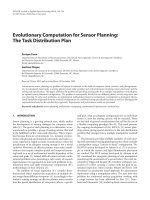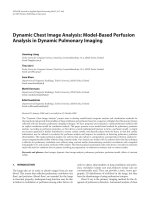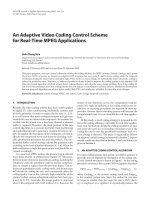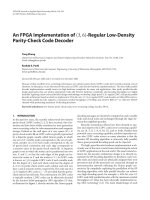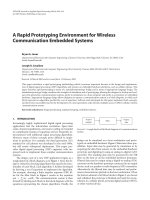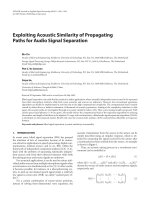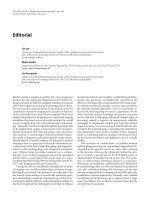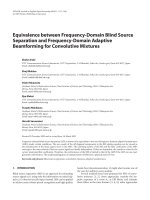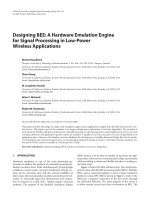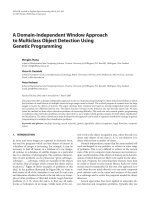EURASIP Journal on Applied Signal Processing 2003:5, 403–404 c 2003 Hindawi Publishing ppt
Bạn đang xem bản rút gọn của tài liệu. Xem và tải ngay bản đầy đủ của tài liệu tại đây (503.81 KB, 2 trang )
EURASIP Journal on Applied Signal Processing 2003:5, 403–404
c
2003 Hindawi Publishing Corporation
Editorial
Jiri Jan
Department of Biomedical Engineering, Faculty of Electrical Engineer ing and Communication,
Brno University of Technology, Purkynova 118, CZ 612 00 Brno, Czech Republic
Email:
Milan Sonka
Department of Electrical and Computer Engineering, The University of Iowa, 4322 SC, Iowa City, IA 52242, USA
Email:
Ivo Provaznik
Department of Biomedical Engineering, Faculty of Electrical Engineer ing and Communication,
Brno University of Technology, Purkynova 118, CZ 612 00 Brno, Czech Republic
Email:
Modern medical imag ing is perhaps the most progressive
and also the most appreciated diagnostic tool in health care.
Images provided by different imaging modalities correspond
well to the background anatomical knowledge and are there-
fore well accepted and understood by the medical staff.The
contribution of modern imaging to the progress of medicine
and level of health care is thus widely recognised. While there
is admirable progress in designing new or innovated imaging
modalities often based on new physical principles, the overall
success is equally due to the computational part of the imag-
ing. All modern medical imaging modalities use image data
in the digital form. Image reconstruction from incompre-
hensible projection data, their processing, noise and distor-
tion removal, or various display methods matched to partic-
ular needs of diagnostics, all depend heavily on the compu-
tational aspects of medical imaging. The progress in medical
imaging is thus in a great part a success of information pro-
cessing, both on the side of algorithm design and implemen-
tation, as well as utilising large-scale-integration-based hard-
ware. Without being too visible, computers are a substan-
tial part of any modern imaging system and the specialised
software forms a great deal of the system value, the corre-
sponding algorithms being often the well guarded “family sil-
ver” of the imaging systems producing firms.
During the last two decades, the de velopment in medi-
cal imaging was crucially conditioned by inclusion of com-
plex digital processing of the measured raw image data. This
has formed a great number of scientifically interesting prob-
lems and has lead to solutions reflecting the properties of im-
age data provided by different medical imaging modalities. It
has been recognised that utilising the knowledge of physical
mechanisms behind each modality, or identifying modality-
specific data propert ies, can significantly contribute to the
efficiency of designed processing methods. The image analy-
sis methods needed, for example, in tissue charac terisation,
are typically modality-dependent; at least in parameter se-
lection but often requiring new specific approaches. On the
other hand, the medical knowledge of anatomic structures
can be used with an advantage during the analytic phase of
processing, namely to improve the segmentation reliability
and quality of visualisation. Another area typical for medical
image processing concerns merging of multimodal data into
consistent three-dimensional or (including time-dimension)
four-dimensional data blocks enabling better diagnosis
based on combining different-modality information. All in
all, the list of contributions and application areas is virtually
endless.
New methods or modifications of modality-oriented
medical image processing are continuously designed and de-
veloped but the research reports are often rather scattered
in the literature. This was the philosophy behind the deci-
sion to prepare a special issue of the EURASIP Journal on
Applied Signal Processing devoted to this area. The invita-
tion to submit papers describing advances in acquisition,
restoration, reconstruction, segmentation, and visualisation
of medical image data was thus formulated. Contributions
were also considered dealing with the impact of the new
data-processing methods to imaging process itself, and to the
possibilities of clinical applications. Naturally, only a limited
contribution in this direction can be expected from a sing le
issue. Nevertheless, the contributors’ response shows that the
concept found its audience.
404 EURASIP Journal on Applied Signal Processing
Out of twenty submitted papers, nine have been finally
selected by the Guest Editors, taking into account the eval-
uations via standard international peer-review process. The
selected papers cover a wide range of imaging modalities: pri-
marily the magnetic resonance imaging (papers by Lethmate
et al. and Positano et al.), X-ray CT (P
´
u
ˇ
cik et al.), X-ray pro-
jection (
¨
Oktem et al. and Liang et al.), γ-ray SPECT imag-
ing (Lundqvist et al.), and ultrasonic imaging (Argenti et al.
and Mischi et al.); each dealing with a particular problem in
data processing or interpreting. The paper by Yang et al. rep-
resents a method applied to different modality images. The
classification of papers could be based on other viewpoints
as well (e.g., mathematical background, medical application
area, etc.) but the selected one is the most natural with re-
spect to the special issue characterisation.
The Editors were primarily seeking high-quality research
papers presenting methods evaluated against state-of-the-art
solutions. Whether the goal was reached is for the reader to
assess. If the conclusion is positive, the objective followed by
the Guest Editors is fulfilled.
Jiri Jan
Milan Sonka
Ivo Provaznik
Jiri Jan graduated in electrical engineering
(1963), received his Ph.D. degree in 1969,
the prime scientific grade from the Czech
Academy of Sciences (Prague 1986), and
became Full Professor of electronics (Brno
UT) in 1991. After publishing in the ar-
eas of numerical antenna—and later also
circuit—analysis, he has been specialised in
digital signal and image processing since the
seventies, including applications in biomed-
ical engineering. In the last ten years, he steered several interna-
tional and national grant projects sponsored by European Com-
mission (TEMPUS, COPERNICUS) and by the Grant Agency of
Czech Republic. He has published over 200 papers mostly in in-
ternational journals and conferences and the book Digital Signal
Filtering, Analysis, and Restoration (IEE Publishing, London, UK,
2000) that appeared partly modified also in Czech (1997, 2002).
Recent international activities: Associate Editor of IEEE Trans. on
Biomedical Engineering (1996–2001); EURASIP Central European
Liaison since 1994; National Board member of the Czech Soci-
ety for Biomedical Engineering since 1990; member of the edito-
rial board of EURASIP Journal on Applied Signal Processing since
2000; founding member of Engineering Academy of the Czech Re-
public (since 1994); Chair of International Program Committee of
Biennial EURASIP Conference BIOSIGNAL ’xx (supported also by
IEEE-EMBS), etc. Jiri Jan is presently the Head of the Department
of Biomedical Engineering, and the Coordinator of the Institute for
Signal and Image Processing (ISIP), Faculty of Electrical Engineer-
ing and Communication, Brno University of Technology, Czech
Republic.
Milan Sonka received his Ph.D. degree in
1983. He is Professor of electrical and com-
puter engineering at the University of Iowa,
and a Fellow of IEEE. Sonka’s research inter-
ests include knowledge-based medical im-
age analysis. He is the first author of the
book Image Processing, Analysis, and Ma-
chine Vision which was published in 1993
by Chapman and Hall in London, 2nd edi-
tion 1998 by PWS, Pacific Grove, Calif. He
has coedited Handbook of Medical Imaging, Volume II—Medical
Image Processing and Analysis published in 2000 and coauthored
several other books and numerous journal and conference papers.
He currently chairs the SPIE International Symposium Medical
Imaging—Image Processing. He is an Associate Editor of the IEEE
Transactions on Medical Imaging and a member of the editorial
board of the International Journal of Cardiovascular Imaging.
Ivo Provaznik was born in 1968. He re-
ceived the M.S., Ph.D., and D oc. degrees
in 1991, 1996, and 2002, respectively, all in
electrical engineering from Brno University
of Technology, Faculty of Electrical Engi-
neering and Communication, Brno, Czech
Republic. In 1997–1998, he was a visiting
Scientist at the Johns Hopkins University in
Baltimore, Md, USA. In 2002, he became
Associate Professor in the Department of
Biomedical Engineering of Brno University of Technology. His cur-
rent research interests are in the areas of biological signal process-
ing, time-frequency analysis of trends in biological signals, medical
image visualisation, and medical image analysis. He has published
over 50 journal papers and conference abstracts. Dr. Provaznik is a
member of the editorial board of Czech Scientific Journal Physician
and Technology. He has been a Chairman of the Organizing Com-
mittee and a member of Program Committee of International Con-
ferences BIOSIGNAL. Dr. Provaznik was awarded the Prize of the
Minister of Education of the Czech Republic TALENT ’94 for con-
tribution to science and research (1995) and First Prize in Young
Scientists Competition at International Symposium IMEKO TK-13
(1995). His area of expertise includes signal processing and analy-
sis, image processing and analysis, time-frequency analysis, wavelet
transform, and adaptive systems.
